The AI tool market is crowded and loud. Every week, a new tool pops up promising to be the only tool you could ever need. Some are useful, many are gimmicks, and others… are likely not going to live to see version 2.0.
So where does Goodie fit in? Full disclosure: We may have a little something to do with the tool 😬 But before you roll your eyes and expect me to give you a puff piece, let me stop you right there. This isn’t about hype, my friends; I’m here to tell you about what the tool actually does, where it shines, and where it still has growing to do (because I’m really just a critic at heart).
I’m covering what Goodie is, key features, how it stacks up against the competition, and whether it’s worth your precious time and budget. I’ve watched Goodie since its humble beginnings, so who better if not me to tell you about it?
What Is Goodie?
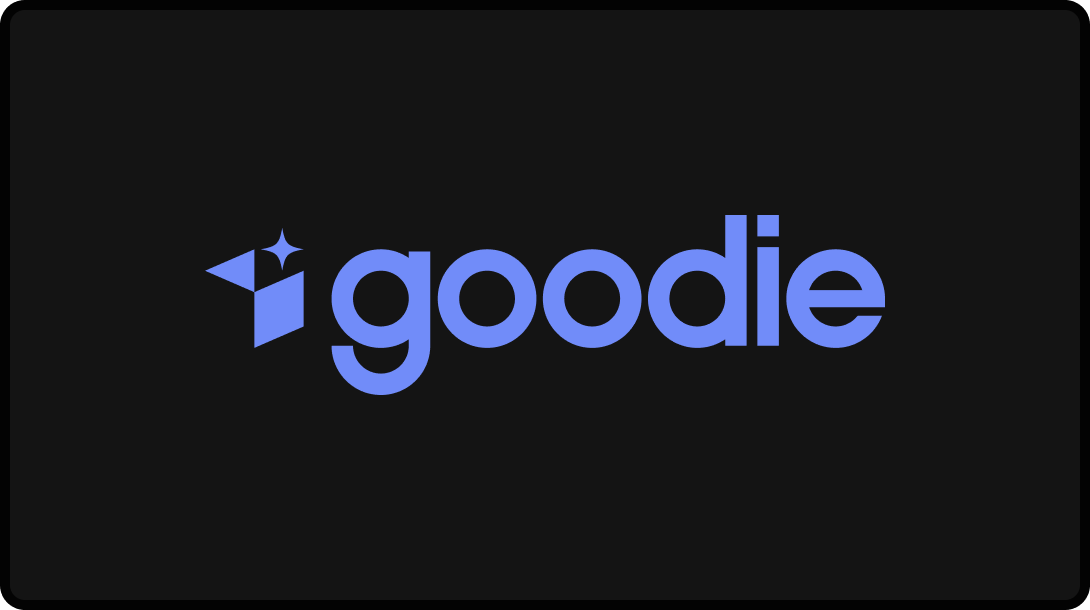
Goodie is an Answer Engine Optimization (AEO) platform built to track and improve how brands show up in AI search results. Instead of focusing on traditional rankings in Google’s “10 blue links,” Goodie zooms in on where your content appears inside AI Overviews, ChatGPT, Gemini, Claude, and other large language models (LLMs).
Think of Goodie as a visibility radar: instead of checking if you’re on page one of Google, you’re checking if you’re being cited, mentioned, or trusted in the responses AI gives users.
Unlike AI writing tools like Jasper or Writesonic, Goodie does more than just generate content for you. Goodie acts as your AI watchdog, showing you when, where, and how your brand gets pulled into AI answers and when your competition is stealing your spotlight.
In short:
- Traditional SEO = optimizing for clicks.
- Goodie = optimizing for citations inside AI responses.
How Is AI Changing Search Engines?
Okay, before we dive into the key features Goodie offers, let’s review why Goodie was created in the first place. You likely know about SEO, but search is changing; meaning the work doesn’t stop at “ranking #1”.
Search engines used to be pretty simple. You type in a keyword, scroll through the list of results, and click around until you (hopefully) find what you need. But now, things look a little different.
With the rise of AI Overviews, ChatGPT, Gemini, and Perplexity, the “answer” is no longer ten blue links; it’s one neatly packaged summary, often stitched together from multiple sources. Instead of browsing websites, users get an instant, conversational response.
That’s convenient for searchers. For brands? It’s a new headache. Your content might still exist on page one of Google, but if AI is summarizing the answer without naming you, you’ve essentially gone invisible.
This shift is why Answer Engine Optimization (AEO) has become a thing. It’s about making sure AI models don’t just find your content, but actually cite, mention, and surface your brand in their responses.
In other words: SEO is still alive, but it’s got a new roommate. And that roommate is the kind who reorganizes the kitchen, whether you like it or not.
Goodie’s Key Features
Goodie isn’t trying to replace your entire SEO stack. It’s built to fill the gap some companies don’t even realize they have yet: visibility in AI search. Here’s a closer look at what you’ll see if you were to log in today:
AI Search Tracking
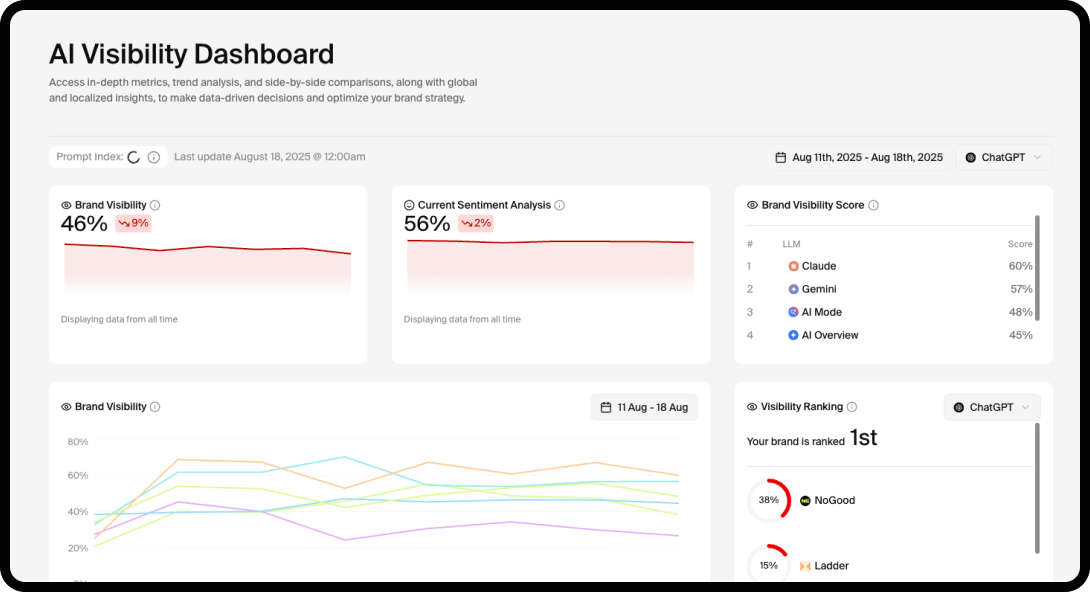
After the onboarding process is completed, Goodie continuously checks platforms like ChatGPT, Gemini, Perplexity, and Google’s AI Overviews to see if you’re being cited. The interface shows where you’re mentioned, how often, and in what context.
- How it feels in practice: Imagine running a keyword report in Ahrefs, but instead of “ranking position,” you’re seeing “AI citations” across multiple engines.
- Why it matters: If you’re not being named in AI answers, users may never know you exist, even if you rank high on Google.
Competitor Benchmarking
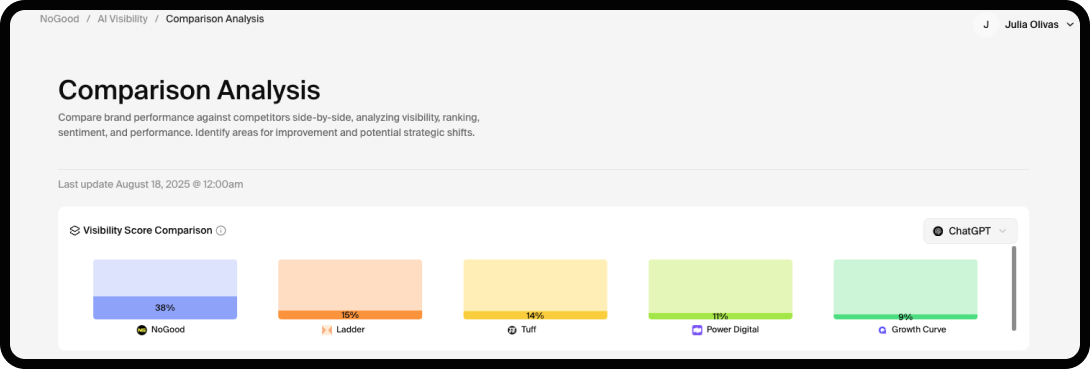
Goodie doesn’t just track you. It also compares your AI visibility against your competitors. You can see which of your rivals are being pulled into answers more often (and for what kinds of queries).
- How it feels in practice: Think of it like a Share of Voice report, but in AI conversations instead of SERPs.
- Why it matters: It’s one thing to know you’re invisible. It’s another to see your competitor consistently getting the citations you’re missing. 💔
Outreach Agent
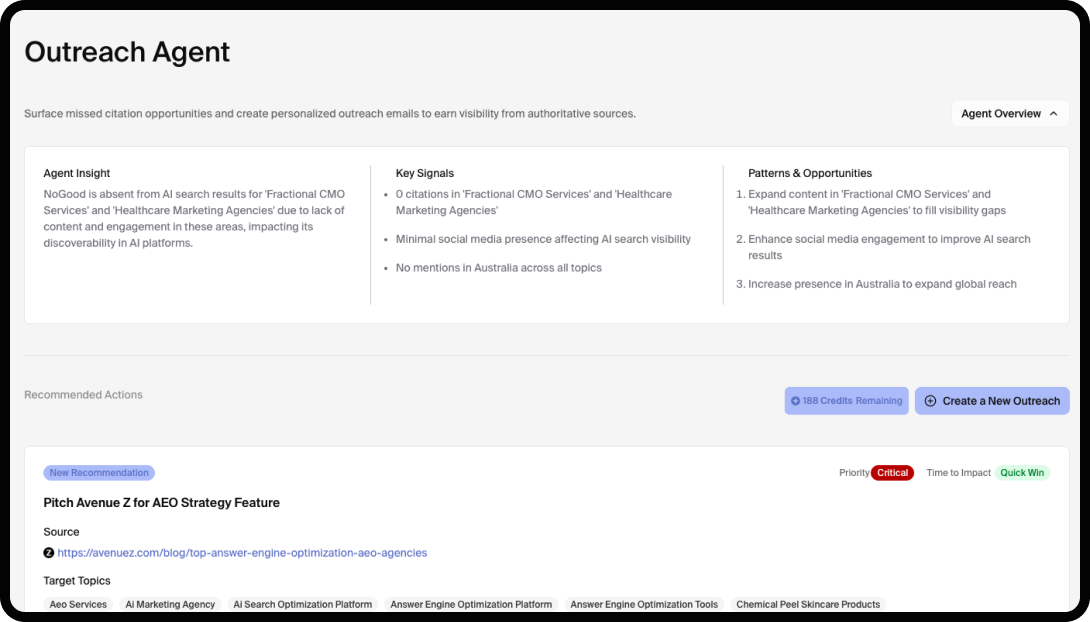
This is where Goodie moves from insights to action. When the platform detects missed citation opportunities, it helps you generate personalized outreach emails to authoritative publishers and sources.
- How it feels in practice: Like having a PR assistant built in; surfacing opportunities and drafting emails you can send to earn those mentions.
- Why it matters: Visibility in AI answers often comes from being cited in trusted third-party sources. Agentic Actions helps you earn that trust at scale.
Content Gap Insights
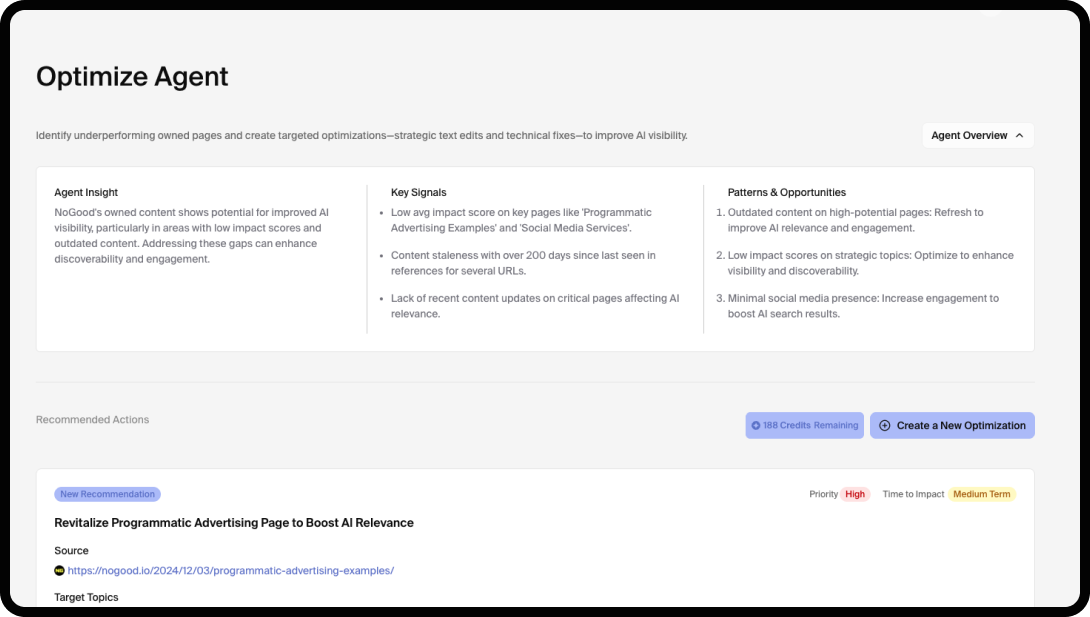
Noticed that AI never mentions you for certain topics, even though you’ve got content on them? Goodie highlights where those disconnects exist. It also surfaces topics and sources you haven’t covered but that AI is leaning on heavily.
- How it feels in practice: Like a gap analysis tool in SEO, except instead of keywords you’re missing, it’s trusted citations you’re either missing entirely (or just the mark) on.
- Why it matters: AI can’t cite what you don’t publish. Filling these gaps makes it more likely your brand will appear in future answers.
AI Content Writer
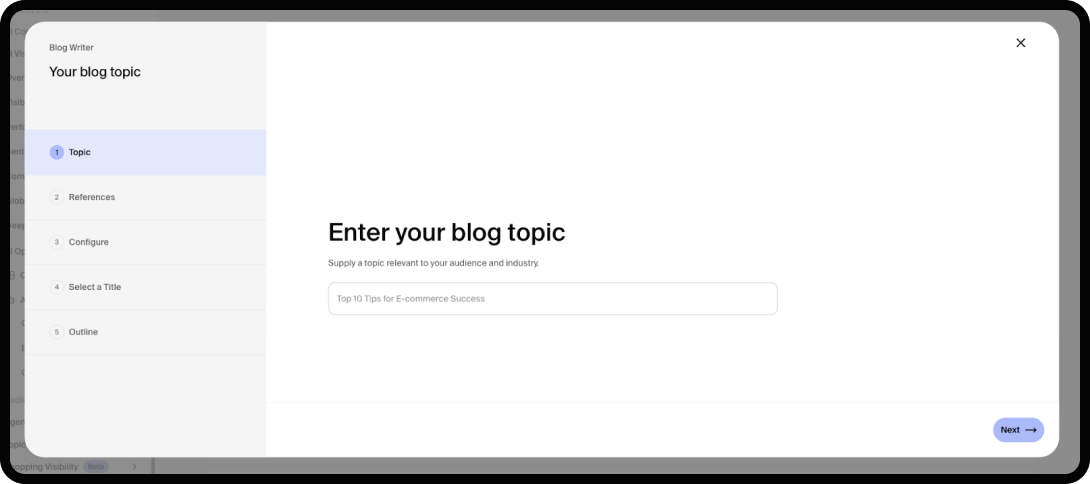
While Goodie’s primary job is visibility tracking, it does include a content writer currently focused on blog creation. The writer helps you draft AI-friendly posts, while the optimizer audits your drafts against AI visibility best practices.
- How it feels in practice: A lightweight Jasper or Writesonic, but tuned specifically for AEO, not generic copy.
- Why it matters: If you’re short on content resources, these agents give you a jumpstart on creating the type of content more likely to surface in AI responses.
Centralized Analytics Dashboard
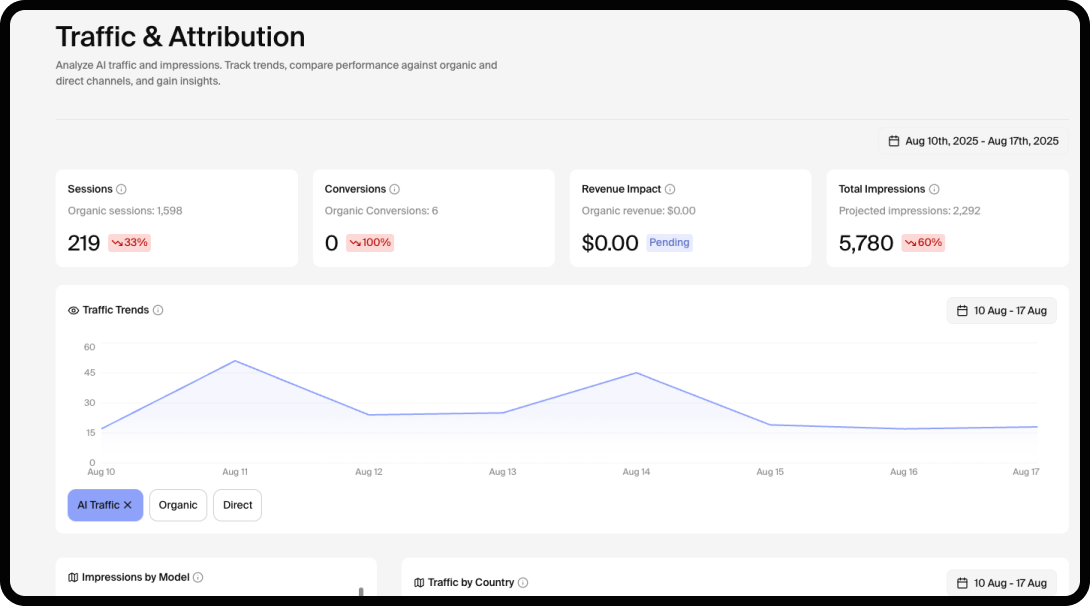
All of these insights live in one hub, where you can monitor your AI visibility over time, track improvements, and share reports with your team.
- How it feels in practice: Like a marketing dashboard you’d build in Looker or GA, but 100% focused on AI search visibility.
- Why it matters: Without central reporting, AI visibility feels abstract. Goodie makes it concrete, measurable, and trackable.
Pros & Cons of Goodie
No tool is perfect, and we’re not here to convince you that Goodie’s the exception. Here’s where it shines (and where it still has room to grow).
Pros
- Laser-focused on AI search: Goodie looks at how AI models like ChatGPT, Gemini, and Perplexity summarize and cite information. That focus makes it one of the few platforms solving a real, emerging gap.
- Agentic Actions = visibility you can act on: Knowing you’re missing citations is one thing. Goodie takes it further by surfacing specific opportunities and helping you spin up personalized outreach emails to authoritative publishers. It’s not just insight, it’s the next steps; all baked into the workflow.
- Competitor benchmarking that actually matters: Instead of vanity metrics like “Domain Authority,” you get visibility comparisons that show exactly how often your competitors are being cited in AI results. It’s like pulling back the curtain on who AI trusts more and why.
- Complements your SEO stack: Goodie isn’t here to replace Ahrefs, Semrush, or GA4. It layers on top, giving you an additional lens (AI search visibility) that those tools don’t cover. Think of it as adding radar to your toolkit, not swapping out the compass.
- Early-mover advantage: Because AEO is still a new territory, using Goodie now puts you ahead of the curve. While other brands are just waking up to the fact that AI can “forget” them, you’re already tracking and fixing it.
Cons
- The feature set is still growing: AEO as a discipline is newer, and so is Goodie. This means it doesn’t (yet) have the decades of bells and whistles a Semrush or Ahrefs can offer. If you’re looking for site audits, keyword explorers, or backlink crawlers, this isn’t that tool.
- Mindset shift required: Traditional SEO gives you nice, clean numbers: keyword rankings, search volume, traffic. AI search visibility is fuzzier; you’re looking at citations and mentions in synthesized responses. It’s valuable, but it takes some recalibration to wrap your head around.
- Niche use case: If you’re a solo blogger or running a hobby site, Goodie might feel like overkill. Its real value shines for growth teams, agencies, and brands with reputations (and revenue) tied to what people see in AI search.
- Still needs evangelizing: Since AEO is such a new concept, you may find yourself explaining internally why AI visibility even matters. The tool is powerful, but you’ll need buy-in from stakeholders who are still thinking in “page one of Google” terms.
In short: Goodie may be new, but so is AEO in itself. This tool is dedicated to evolving AEO as a discipline, and behind it is a team of experimenters focused on uncovering how trust drives visibility, and how visibility drives customers to your business.
Who Is Goodie Best For?
Goodie isn’t built for everyone (and that’s kind of the point). This AI visibility tool is designed for teams where it impacts business outcomes. If your customers are turning to ChatGPT, Gemini, or Google AI Overviews for answers, then making sure your brand shows up isn’t optional.
Goodie is best suited for:
- Marketing leaders who need to understand how their brand is represented (or overlooked) in conversational AI.
- SEO and growth teams who need visibility metrics beyond keyword rankings, showing how often their brand is cited.
- PR and communication teams, where reputation hinges on being cited as a trusted source and represented in AI-summarized narratives.
- Agencies and consultants who want to give clients a competitive edge by reporting on AI visibility alongside traditional SEO metrics.
Who it’s less useful for:
- Teams looking for a full-service writing suite: Goodie does have a blog-focused content writer agent and an optimization agent, but if you’re looking for a tool dedicated to AI content writing, you won’t find it here.
- Businesses without a content or brand strategy: If you don’t publish content or have a digital content strategy at all, there won’t be much for Goodie to track and optimize.
All summed up, Goodie is for marketing teams (whether you work for an agency or in-house) who want to know and control how your brand is represented when AI’s doing the talking. Plus some bonus tools to strengthen the content feeding into that visibility.
Alternatives to Goodie
AI this, AI that; nowadays, everyone seems to have an “AI-powered” tool for any task involving a computer (and even some that don’t). And AI SEO/AEO/GEO (whatever we’re calling these days) is no different. To alleviate your confusion, here’s how Goodie stacks up compared to the ones you’ll see most often in the conversation:
- Writesonic or Jasper: These tools both started as AI writing assistants that have now layered on “AI SEO” features, like content scoring and platform optimization. Helpful if you need to generate blog posts at scale with a better shot of being AI-friendly. But their focus remains on content creation, not visibility tracking. Once the content is out in the wild, they don’t monitor how often AI actually cites or surfaces it.
- Am I on AI?: A straightforward “yes or no” checker indicating whether or not your brand appears in AI answers. It scratches the curiosity itch, but stops there; no gap analysis, no competitor benchmarking, and no outreach actions. Think SparkNotes version of what Goodie delivers in full.
- Traditional SEO Suites (Ahrefs, SEMrush, Moz, etc.): These remain the gold standard for keyword research, backlink analysis, and technical SEO. And some have even begun acknowledging AI search, but their toolsets aren’t built for AI visibility monitoring at scale. Goodie fills that gap, working alongside, not replacing, the SEO stack you already use.
If AI writing tools help you create content, Goodie is what helps make sure AI actually remembers you exist once that content is live.
Final Verdict: Is Goodie Worth It?
If you’re looking for a tool that writes your entire marketing strategy for you, Goodie isn’t it (if you find one that does do that, let me know). But if you’re a marketer, agency, or brand leader who wants to know how AI search engines feel and talk about you (and whether they even think about you at all), then yes, Goodie is worth it.
What sets it apart isn’t just the tracking. It’s the spotting of missed citation opportunities, benchmarking against competitors, and even assisting in outreach. Add in a blog-focused writer and optimization agent (with V2 rolling out soon, by the way), and you’ve got a platform that’s evolving right alongside the discipline it’s built for.
Goodie may be new, but so is AEO. Behind the tool is a team dedicated to understanding and shaping how brands earn trust and visibility in our AI-hyped world. Early adopters get the advantage here. While others are still measuring rankings, you’re measuring relevance.






